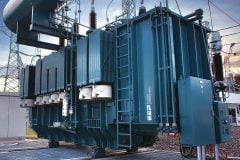Principle of Operation

A current transformer is defined as as an instrument transformer in which the secondary current is substantially proportional to the primary current (under normal conditions of operation) and differs in phase from it by an angle which is approximately zero for an appropriate direction of the connections. This highlights the accuracy requirement of the current transformer but also important is the isolating function, which means no matter what the system voltage the secondary circuit need to be insulated only for a low voltage.
The current transformer works on the principle of variable flux. In the ideal current transformer, secondary current would be exactly equal (when multiplied by the turns ratio) and opposite to the primary current.
But, as in the voltage transformer, some of the primary current or the primary ampere-turns are utilized for magnetizing the core, thus leaving less than the actual primary ampere turns to be transformed into the secondary ampere-turns. This naturally introduces an error in the transformation. The error is classified into current ratio error and the phase error.
Definitions
Typical terms used for specifying current transformer are:
Rated primary current
The value of current which is to be transformed to a lower value. In CT parallence, the load of the CT refers to the primary current.
Rated secondary current
The current in the secondary circuit and on which the performance of the CT is based. Typical values of secondary current are 1 A or 5 A.
Rated burden
The apparent power of the secondary circuit in Volt-amperes expressed at the rated secondary current and at a specific power factor.
Composite Error
The RMS value of the difference between the instantaneous primary current and the instantaneous secondary current multiplied by the turns ratio, under steady state conditions.
Accuracy limit factor
The value of primary current up to which the CT compiles with composite error requirements. This is typically 5, 10 or 15, which means that the composite error of the CT has to be within specified limits at 5, 10 or 15 times the rated primary current.
Short time rating
The value of primary current (in kA) that the CT should be able to withstand both thermally and dynamically without damage to the windings with the secondary circuit being short-circuited. The time specified is usually 1 or 3 seconds.
Class PS/ X CT
In balance systems of protection, CT s with a high degree of similarity in their characteristics are required. These requirements are met by Class PS (X) CT s.
Their performance is defined in terms of a knee-point voltage (KPV), the magnetizing current (Image) at the knee point voltage or 1/2 or 1/4 the knee-point voltage, and the resistance of the CT secondary winding corrected to 75C. Accuracy is defined in terms of the turns ratio.
Knee point voltage
The point on the magnetizing curve where an increase of 10% in the flux density (voltage) causes an increase of 50% in the magnetizing force (current).
Summation CT
When the currents in a number of feeders need not be individually metered but summated to a single meter or instrument, a summation current transformer can be used.The summation CT consists of two or more primary windings which are connected to the feeders to be summated, and a single secondary winding, which feeds a current proportional to the summated primary current.
A typical ratio would be 5+5+5/ 5A, which means that three primary feeders of 5 are to be summated to a single 5A meter.
Core balance CT (CBCT)
The CBCT, also known as a zero sequence CT, is used for earth leakage and earth fault protection. The concept is similar to the RVT. In the CBCT, the three core cable or three single cores of a three phase system pass through the inner diameter of the CT.
When the system is fault free, no current flows in the secondary of the CBCT. When there is an earth fault, the residual current (zero phase sequence current) of the system flows through the secondary of the CBCT and this operates the relay. In order to design the CBCT, the inner diameter of the CT, the relay type, the relay setting and the primary operating current need to be furnished.
Interposing CT’s (ICT’s)
Interposing CT’s are used when the ratio of transformation is very high. It is also used to correct for phase displacement for differential protection of transformer.











Hi Sir,
Thank you for your articles , these are so helpful for us.
Sir, can be give me some explanation on CT star point concept (where does the star point face, where should the P1 ans P2 of CT face).Expecting your reply.
Thank you